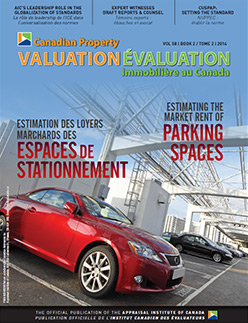A Professional Appraiser’s Perspective – Reserve Fund Studies are key components to long-range financial planning
Canadian Property Valuation Magazine
Search the Library Online

Since his boutique consulting services firm focuses exclusively on Reserve Fund Studies (RFSs) in Alberta and Depreciation Reports in British Columbia, we asked Ernie to share his experience, expertise and knowledge relative to the specialized field of Reserve Fund Studies.
What is the basic concept of a Reserve Fund Study (RFS)?
The Reserve Fund Study, referred to as a Depreciation Report in British Columbia, is a long-range financial planning tool that identifies the current status of the capital reserves and provides a funding plan to offset the anticipated future replacement of major components.
What are the main components of an RFS?
The two main components of an RFS are the Physical Analysis and the Financial Analysis. An RFS report is a financial document that identifies the estimated costs associated with the repair or replacement of major components within a long-range plan, typically 25 or more years.
What types of organizations require or request an RFS?
Typical clients for an RFS are condominium and strata corporations, non-profit housing and homeowner associations, housing co-operatives, time-share hotels and resorts, and long-term care and/or seniors housing facilities.
What sorts of property assets are taken into consideration in an RFS?
Typically, all of the assets that are expected to require significant repair or replacement within the life of a property are taken into consideration when completing an RFS. We look at everything from the electrical and mechanical systems, doors and windows, roofing and exterior finishes to roadways, parking lots and landscaping.
Are there different levels or degrees of complexity in an RFS?
The complexity of an RFS depends on the property or asset being taken into consideration. An RFS can be quite simple and completed on a couple of items such as fencing and landscaping for a community association. Alternatively, the assignment may be quite complex and consist of a multi-use property such as a multi-building, hi-rise complex with office towers, hotel and residential units.
Are there specific standards of practice relative to an RFS?
Fortunately for members of the AIC, the Canadian Uniform Standards of Professional Appraisal Practice (CUSPAP) have recognized Reserve Fund Studies as a consulting activity since 2005. New to CUSPAP 2014 is a standalone Reserve Fund Planning Standard, with compulsory Rules and Comments, with an expanded scope of practice for Designated Members holding the Canadian Residential Appraiser designation. As with any professional service, AIC Members are required to have the competence to undertake any assignment, and this extends to Reserve Fund Studies.
“The Reserve Fund Planner can play a wide variety of roles. It is quite possible that he or she would lead and coordinate a multi-disciplinary team. It is also common for an individual Reserve Fund Planner to complete all aspects of the RFS assignment.”
What types of professionals can be involved in conducting an RFS?
Reserve Fund Studies are subject to provincial legislation (i.e., regarding certain property types, recognized qualifications and professionals). Members are expected to familiarize themselves with the legislative requirements within the property’s jurisdiction prior to undertaking an RFS assignment and are reminded that legislation supersedes CUSPAP.
In Canada, the Real Estate Institute of Canada (REIC) and, more recently, the University of British Columbia (UBC) offer courses towards the achievement of a designation – the Certified Reserve Planner (CRP) designation program from REIC – and certification of completion – Award of Completion Certification of the UBC Reserve Fund Planning Program (RFPP).
However, it is important to note that the CRP and RFPP programs may not be enough to demonstrate competency of the Reserve Fund Planner and that additional experience may be required.
Is it usually a multi-team approach involving different types of professionals?
There is no requirement to have a multi-team approach, although having a multi-disciplinary team could prove beneficial, particularly on more complex assignments. The team would depend on the complexity of the assignment and could consist of the Reserve Fund Planner (RFP) – which may be an AIC designated appraiser – and a variety of other qualified and competent professionals such as various engineering specialists, architects and tradespersons familiar with the construction, maintenance and replacement of the various components.
What role does a reserve fund planner typically play in an RFS?
The RFP can play a wide variety of roles. It is quite possible that he or she would lead and coordinate a multi-disciplinary team. Depending on the RFP’s competence, it is also common for an individual RFP to complete all aspects of the RFS assignment.
What specific skill sets would an RFP require to effectively conduct or contribute to an RFS?
In order for an RFP to be effective, he or she needs a wide variety of skill sets. First, if the property is a condominium, the RFP needs to understand how the appropriate provincial Act and Regulations pertain to the assignment.
The RFP also requires the ability to decipher and carry out calculations based on a variety of financial and technical documents. He or she should possess the financial acumen to reasonably assess inflation rates, future returns on investment, and how the cost of living affects reserve fund performance.
When completing the site inspection, the RFP should have an understanding of the various building components and how they function, along with the ability and competence to recognize signs of early component failure. He or she should have significant knowledge on the effects of preventive maintenance on the lifespan of the equipment and building, and an understanding of the likelihood of repairs or replacement based on previous decisions of completing or deferring repairs or replacement.
The ability to write a comprehensive, yet easy to understand report is also a desirable trait.
What are the biggest challenges an AIC-Designated Member might face in carrying out an RFS?
In some Canadian provinces, there is no specific legislation that qualifies who can complete an RFS. This can create the challenge of educating the client that a competent AIC-Designated Member can provide reliable and professional RFS.
Fortunately, in provinces such as Ontario, legislation identifies the designated professionals who can complete an RFS. Among them are AIC Designated Members and individuals holding the CRP designations, to name a few. This extends to CRA-Designated Members who maintain the CRP designation, keeping in mind that, in Ontario, it is the CRP and not the CRA designation that is recognized, regardless of the provisions in CUSPAP.
What prompted you to specialize in this area personally and with your company?
Even while I was a property manager, the RFS concept was quite interesting to me, so the decision to focus or specialize was quite easy. Ultimately, a conscious decision was made to pursue an exclusive practice in the RFS and Depreciation Report field. Although I know it may not be for everyone, for me it is an area of the profession that has the right balance of challenge and return.
Is this a growth area for AIC Members?
Yes. Although in provinces such as Alberta and Ontario a number of providers have been completing this work for over 15 years, it is an emerging growth area in British Columbia because of the legislative changes. There have been many new entrants to the field within the past few years.





